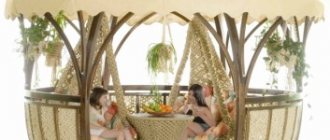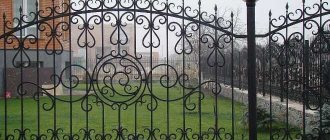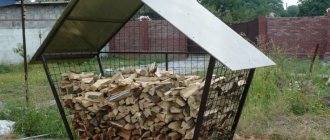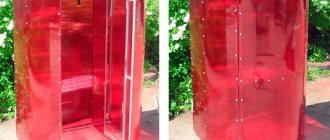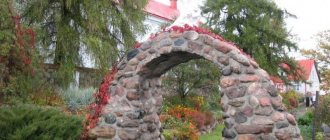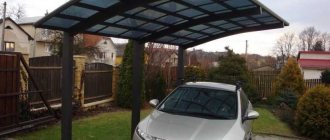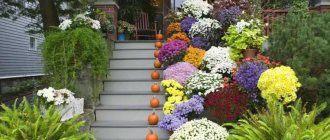Functions of garden borders
In addition to decorative and aesthetic purposes, fences for beds and flower beds have important practical benefits:
- give neatness to beds and flower beds;
- limit the growth of weeds that cannot penetrate beyond the boundaries of the buried border;
- keep cultivated plants and flowers in a limited area;
- prevent the soil from crumbling when watering and preserve its fertile layer;
- reduce the movement of crawling pests;
- provide more rational watering;
- simplify plant care: weeding, fertilizing, weed removal and other gardening activities;
- It is easier to cover fenced plants with film, install greenhouse arcs, and arrange warm and high beds for heat-loving crops.
How to care for garden beds
To get a good harvest, it is not enough to build a bed; it must be constantly looked after. Fertilizers are periodically added to the soil. Many gardeners limit themselves to this, ignoring the subsoil layer, which becomes compacted over time. As a result, it stops allowing water and air to pass through, prevents root growth, and accordingly, plants slow down and stop bearing fruit.
Experienced gardeners recommend deep loosening every 1-2 years in the fall, especially the subsoil layer, to a depth of 60-90 cm. After such actions in the spring, it is enough to just dig up the top layer, apply fertilizer, the volume of which should not exceed the norms established for a regular vegetable garden, without equipped ridges.
For the winter, it is necessary to protect the soil from weathering and cover it with polyethylene. In the spring, before planting, you should check the integrity of the enclosing structure and, if necessary, strengthen it. For each bed, you need to select appropriate types of plants that will not compete for the same nutrients.
Wooden garden borders
Wood is the most popular material for making flower beds and beds. Wood is attractive for its environmental friendliness, affordable cost and good repairability. The disadvantage of wooden products is rapid deterioration, especially in conditions of high humidity and constant contact with the ground. Special antiseptic agents help to briefly extend the life of wood.
Wooden border can be made from the following materials:
- Boards. The easiest and most reliable way to arrange a bed or flower garden is to put together a strong box. You can use the boards to make multi-tiered flower beds or create a high bed for fruit and vegetable plants.
- Wattle fence. A decorative border made of vines is an excellent option for flower beds in a rustic style. Moreover, it is completely free if you produce and search for the material yourself. Most often, flexible willow branches are used for wattle, although these can be any branches of sufficient length and elasticity.
- Border for beds and flowers made of chocks. Small diameter logs can be used as an original fence for flowers or plants. Sawed logs of the required length are buried vertically along the perimeter of the flowerbed. For greater durability, the lower ends of the logs can be wrapped in roofing felt or dipped in bitumen mastic.
Types and features of fencing
To make a fence, unprocessed natural material can be useful: stones, cobblestones, willow rods or wooden pegs. Thrifty owners use the material left over after construction or renovation: slate, brick or boards. An option for those who are interested in the durability of structures is metal structures.
Stone fence in Scandinavian style
A fence made of stones meets all the necessary requirements so that cultivated plants feel cared for and produce a good harvest. Natural material can simply be collected on the banks of rivers or even on your own site. To delimit the territory, you can frame the bed with cobblestones, and the decorative element will decorate the garden.
Stones and cobblestones are difficult to match to one size, so they will have to be secured with cement. They can be used to build high beds where weeds cannot reach. The earth warms up faster, which means an early harvest is guaranteed. Such fences will turn out to be heavy and will sink into the ground. To avoid this, you need to dig a trench around the perimeter and place sand, broken brick or gravel in it. The work invested will pay off handsomely. You can forget once and for all about the constant updating of landing boundaries.
If you use slate slabs or sandstone, you need to fit them tightly together. You will get a wonderful Scandinavian fence.
Natural borders
You can create any form of framing for beds from willow twigs. To do this, you will need to prepare pegs of the required height. Branches of any trees at least one meter long will do. To prevent the pegs from quickly rotting in the ground, it is recommended to install them in a plastic pipe of suitable diameter for the length of their penetration into the ground. Weaving a fence around the perimeter of the garden bed will not require much time or money.
Build two fences of different circles around the tree and fill the soil between them. Plant flowers or moss. This way you will provide a microclimate for the tree and a place for drinking tea. Small diameter logs will make a wonderful fence for a garden bed.
Brick classic design
You can use the remains of bricks from the construction of a house, bathhouse, disassembled stove or balcony. Before laying, it is recommended to prepare a shallow foundation and fill it with cement. Bricks are laid in different ways:
- horizontally;
- vertical;
- flat;
- sideways.
The irregularities of old brick filled with cement will add exoticism to a classic design. The high status of the owners is emphasized by the walls of the house and the beds decorated with the same brick.
This is an ideal material in terms of environmental friendliness, ease of installation, and durability. The masonry can be dismantled without any special equipment. Buying new bricks is not cheap. Installing curbs from used bricks will cost almost nothing.
Wooden fences
The most common are fences made of wooden materials. Your ideas can be turned into reality using inexpensive lumber. You will receive a unique site design that meets environmental requirements. But wood rots easily, and this is its disadvantage. But it is easy to repair. Modern anti-rot products can extend the life of use, but the environmental properties may suffer.
- Beam. It is considered the best option. A plus to its advantages will be the ergonomic wide side on which you can lean or put something without damaging the plants. The relatively high price is compensated by the long service life and reliability of the structure.
- Boards. A budget option. It is enough to lay them on the sides of the beds, securing them with pegs or bricks. This device is environmentally friendly, but short-lived, but can be easily removed if necessary. Boards treated with an antiseptic have a more aesthetic appearance and a longer service life, but you need to be careful with the treatment so as not to harm the plants. To strengthen the border, you can use decorative metal corners.
- Logs. From the trees cut down on the site, you can make a log house of appropriate size for the garden bed. The resulting device is not inferior in quality to timber.
Metal fencing for garden beds
Such a border has undoubted advantages in the form of durability, originality, ease of installation, and compliance with any interior. But it has a significant drawback: the sun increases the temperature of the metal and the soil next to it. Overdrying the soil can adversely affect the growth of plants and their roots may be damaged. Installing them on the sunny side should be done with caution.
In hardware stores you can buy galvanized or polymer metal Euro picket fences of small height. Used for decorative fencing of flower beds and beds. Plantings enriched with this material will look neat; geometric shapes will help to optimally place all the plants on the site. The service life of the material is 50 years, it does not rust or fade in the sun. If price is not your priority, then you should opt for this material and forget about the annual arrangement of beds for many years.
From scrap materials, nets from combines that have fallen into disrepair will come in handy. Their main advantage is ventilation; the holes allow air to pass through. The mesh can be processed and cut with metal scissors. You can easily make a border of the desired size.
Solutions for concrete
Often the site is located on a sloping surface, the beds are formed across the slope . In this case, they need to be strengthened more thoroughly than on a horizontal plane. To solve the problem, we can recommend concrete fortifications. They are used in the form of a poured structure, ready-made blocks or slabs. The sides of the fence can be decorated with garden tiles. This will ensure consistent design and functionality. There is a prominent place for a watering can or tools. You can lean on your elbows while weeding the beds or just sit down. The design will be reliable, but you will have to put a lot of effort into dismantling it if you want to change anything.
Wave slate
The simplicity of fencing construction and durability are combined with a budget option. Slate roofing is not used today. But amateur gardeners liked it as a fence for vegetable beds. The buried part of the slate serves as a barrier against weeds and mole crickets. The material is reinforced along the perimeter with metal pegs. You can use it to make multi-tiered beds or a box for preparing compost.
Plastic fencing
You can stock up on plastic bottles in any quantity. Fill them with the material that is at hand: sand, crushed stone, gravel or just earth. There is room for your imagination: fold with the necks down or up; lay horizontally, fastening with cement mortar; use one color or two colors. The beds can be given any shape. Such fencing is not resistant to mechanical damage. But the family budget will not suffer, not a penny will be spent on fencing.
The ready-made border from the store has remarkable properties: impact-resistant, lightweight, frost-resistant and moisture-resistant. It needs to be buried well into the ground and secured with pegs. It serves as good protection against weeds. A border made of low-quality plastic will last no more than 2 years, even if removed for the winter.
An excellent material for limiting plantings would be the polycarbonate left over after installing the greenhouse.
Plastic for decorating beds and flower beds
PVC borders are practical, attractive and very realistically imitate natural materials: wood, stone, brick or metal. Of the many beneficial properties of plastic products, it is worth noting:
- affordability;
- not susceptible to moisture, rot, fungi and insect damage;
- frost resistance;
- undemanding in care and maintenance;
- easy installation and dismantling;
- ease of construction;
- a wide variety of plastic products;
- durability.
types of plastic borders are especially popular
- Garden ribbons. Flexible PVC border is widely used to mark the boundaries of garden paths, flower beds, and lawns. Also, using plastic tape, you can create beds of different heights - from 20 to 50 cm. The tape has medium rigidity, holds its shape well and is easy to install. Garden tape is sold in rolls. The most popular colors are green and brown.
- Border "Labyrinth". Low plastic fencing under the “stone” look. The presence of small holes and protrusions allows you to use a lawn mower and cut the grass even at the edge of the curb. “Labyrinth” perfectly prevents the penetration of weeds and lawn grass into the territory of a designed flowerbed or bed.
- Panels "Garden Board". A very beautiful and easy-to-install border that resembles a wooden board in appearance. The panels have increased rigidity and strength; they are often used to create sandboxes, multi-tiered flower beds and raised beds. The panels have a length of up to 3 m and a height of up to 15 cm. Special fastenings allow the panels to be increased both in length and in height.
- Garden designer. Flexible decorative fencing consisting of individual parts. The designer is perfect for creating flower beds of any shape. Installation of the border is carried out in a matter of seconds - you just need to stick it into the ground.
- Decorative borders made of plastic. They are presented in a wide variety of colors and shapes - these can be ribbons with various ornaments, imitation picket fences or forged fences.
Advantages of the side and layout options
In the store you can choose borders for flower beds and beds. But if you make them yourself, you will get a durable and exclusive decorative piece for the landscape.
Despite the cost, construction made from such raw materials is considered one of the most common fencing.
The design of a bed made of border granite in the yard
When installing curb fences, the following materials are used:
- sandstone;
- granite;
- basalt.
Beds in the shape of a fountain
The borders of the future bed made of natural granite have the ability to be combined with any design decision of the house, due to which they add pomp and unusualness to the appearance of the garden landscape.
Positive features of decorative fences:
- Long service life. Even after a long time, the fence will not change in appearance and will retain the contours of the bed.
- Due to its strength, it is able to hold soil that is poured above the level of the garden plot.
- The decorative nature of fences is manifested in attractiveness and neatness.
- When agricultural or ornamental crops require greater depth, it is easier to add soil.
- Depending on what type of raw material is used - natural or artificial - they are easily amenable to additional processing. For example: paint it any color.
Note! A stone structure for a garden bed has one significant drawback - over time, the pebbles sink into the soil. Therefore, it is periodically necessary to disassemble, straighten, add soil, and then again lay the cobblestones in their original places.
Fence in the yard
Traditional brick
The brick edging of a flower bed or garden path will look quite organic, especially against the backdrop of a house made of the same material. A brick border can be made in different ways:
- dig straight or at an angle;
- lay out in one or several rows using cement mortar;
- make a raised flower bed of any shape;
- make a border with a barrier for lawn grass by placing one row of bricks on the edge, and digging the second one next to it flat into the ground.
By analogy with brick, paving stones can be used for a neat and durable border. The disadvantage of brick fencing is its high price and stationary nature.
DIY garden bed
To fence an area with natural material, you first need to prepare the place where the structure will be installed. A trench corresponding to the width of the raw materials is dug along the perimeter of the bed and filled with concrete mortar.
Large pebbles are pressed into the concrete, thus laying the first layer of the structure. In the event that several stone rows are provided, they are fastened using a concrete mixture. When laying the material, alternate large stones with smaller ones, the latter should fill the gaps.
Note! A base made of concrete mortar will allow the fence to maintain its shape for a long time, preventing the materials from shrinking.
If you need a low fence made of curb basalt or granite, then there is a simple installation method. To make a fence, take large boulders and dig them lightly into the ground around the perimeter of the bed. This option is good because it does not involve the use of concrete. In this case, without special skills and materials, you can lay out a good version of the fence using large fragments.
A low-level bed that is built without concrete
Note! Using small materials, you can lay out a path or make a stone floor mosaic that will lead to. This idea will decorate the area.
Fencing for garden beds is used in vegetable gardens of small areas. This structure will make the dacha area look neat and tidy. With the help of fences it is easier to care for plant crops.
Average score of ratings is more than 0
Share link
Comments There are no comments yet, but you could be the first...
Natural stone for border
An original flowerbed can be made from natural stone . Of course, to make the fence beautiful and durable, you will have to spend a lot of time and effort. The easiest way to make a border is to lay it out of large stones in one row. More impressive will be flower beds laid out in several levels and secured with cement.
Recent Entries
Chainsaw or electric saw - what to choose for the garden? 4 mistakes when growing tomatoes in pots that almost all housewives make Secrets of growing seedlings from the Japanese, who are very sensitive to the soil
Stone is a heavy material and to prevent such a curb from settling over time, it is advisable to take care of a reliable concrete base. Stone fences are perfect for creating high flower beds and retaining walls in areas with difficult terrain.
Classic stone flowerbed
Now let's look at the stages of creating a stone structure, and look in detail at how to make a flowerbed out of stones and cement with your own hands.
In order to do everything correctly, regardless of the chosen design, a number of important nuances should be observed:
- Choose a place on the site where the flower bed will be planted. If this is an open place, you need to place oval, round and rectangular structures here, which will be viewed from different sides. If the flower beds will be located along paths and walls, you need to use semicircular and rectangular products.
- Select the shape and size of the composition to be created. You need to decide what the stone flowerbed will be like. It is best to prepare a drawing.
- Make markings to create a composition of the desired shape.
- Prepare a place for a flower bed, remove debris and grass.
- Lay out the flowerbed using stones of the required size.
- Plant plants.
Pergones
Another option for fencing using natural stone is pergons. They are a mesh steel frame filled with stones. Other materials can also be used as filling: wood cuts, glass, broken brick .
Pergons are ideal for creating original flower beds, high beds, and retaining walls. This garden border is absolutely environmentally friendly and will not harm plants. If you use inexpensive filler, the cost of a mesh fence will be quite cheap, and installation will not take much time. Pergons do not require a foundation and can be installed on any surface.
Functional features of fencing beds
Staying in a garden plot, where vegetable beds in orderly rows, you can drink tea under the trees, and the branches of the bushes do not hang to the ground, will be as comfortable as possible. Order in the garden creates conditions for peace of mind and happy contemplation of the beauty created with your own hands. What benefits can arranging beds bring, besides improving the decorative appearance? Framing the beds performs the following functions:
- saves time and effort during the spring harvest;
- creates a barrier for weeds;
- preserves and maintains the fertile layer;
- saves water when watering;
- facilitates the installation of covering material.
It won’t take much time to purchase ready-made plastic borders in stores and install them in your garden if you don’t mind the material costs. There is another option - if you have the desire and skill, make them yourself, while saving money.
Concrete garden borders
Concrete curbstones are very attractive and durable.
It is not afraid of high humidity, frost or mechanical pressure. Garden borders made of concrete are a classic element of landscape design; they are used for edging flower beds, garden paths, lawns and various areas on the site. Concrete borders can be purchased ready-made or made yourself. For this purpose, curb blocks are cast in suitable shapes. Another way is to make a monolithic concrete curb. To do this, cement mortar is poured into the installed formwork made of boards or plywood.
The disadvantages of concrete curbs include heavy weight, which makes installation and dismantling difficult. But moving a fence made using the monolithic casting method will not work at all.
Basic properties of borders
Along the edge of the garden plot, a living border of perennial shrubs up to 70 cm high looks great. Dwarf varieties of shrubs or bushy flowers will be an excellent frame for flower beds. For vegetable beds, borders should be practical. Therefore, special requirements are imposed on their device:
- environmental friendliness;
- ease of assembly;
- durability;
- resistance to mechanical damage due to accidental impact with a working tool;
- the strength of the wall, otherwise the wet earth will squeeze it out;
- density of the sides to preserve the fertile layer and water during irrigation;
- compliance of the appearance of the frame with the landscape design of the garden plot;
- the material should not heat up quickly in the sun.
Metal fencing
Modern metal garden borders are made from galvanized steel . Often an additional polymer layer is applied to the galvanized surface of the product. This border for garden beds has a long service life and allows you to solve the issue of arranging your garden plot for a long time. Manufacturers provide a guarantee for galvanized products - 15 years, for beds with a polymer layer - 20 years, and with a polyurethane coating - up to 50 years.
There are many advantages of galvanized fencing:
- corrosion resistance;
- resistance to rot, moisture, mildew and mold;
- lightness and strength;
- durability;
- easy assembly and installation;
- the ability to add length and height to the bed;
- aesthetic and neat appearance;
- harmlessness of the material to the soil.
In addition, galvanized beds are an ideal basis for constructing film-coated greenhouses . The only disadvantage of galvanized metal fences is the high price. Although such an acquisition will pay off over time, not everyone has the opportunity to spend a large amount on decorating a garden bed or flower bed, even despite all its positive aspects.
Purpose of garden fences
Although the beds have a beautiful appearance after fencing, this is not the main task of the sides. Fencing is also installed for practical reasons. The main reasons are:
- To simplify site maintenance. There are fewer weeds than before the framing was installed. And if you sprinkle the paths with sawdust, their number will decrease.
Fencing on a summer cottage
- The need to annually dig up the fertile fertilized layer will no longer be a necessary task, which will save money.
- When installing high garden fences, the height of the fertile layer will increase due to organic mulch or free space will be borrowed from plants.
- If you enclose the flower bed with a border, it will look good with the design of the house. And this will add completeness to the landscape of the yard.
- Decorative fencing will prevent plants from overgrowing. This is necessary because without a border, the flower arrangement may get mixed up and not have the same appearance as planned.
Decorative fence that separates flower varieties
- Caring for perennials becomes easier and damage to flower bulbs is impossible.
- Borders for beds prevent soil from falling onto the paths that surround the flower garden. After all, if a border is not installed on the earthen plot, then the soil that gets on the path will spoil the cleanliness and well-groomed condition.
Decorative fencing near paths
- The presence of a border in the yard sends a message to children and animals that this is not a place for games or other recreational activities. They do not enter areas with plants.
Note! If you install the sides in the greenhouse, this will make it easier to attach the greenhouse arcs. Installing the base on a hard surface will be more convenient than on soft ground.
Installation of borders is necessary both in the yard and in the greenhouse.
Border in a greenhouse
Manufacturing of the structure
We fill the gaps between the stones with earth. It is first compacted. Subsequent masonry is done using mortar, which requires the construction of drainage holes or an underground structure.
The angle of inclination of the dacha plot is preliminarily determined.
Which is better: heated floors or radiators?
Warm floorBatteries
When laying stones with mortar, we use cement only from the inside of the surface of the stones. The “dry masonry” effect must be preserved on the outside of the consumable. When the solution dries, a sealant is applied to the surface of the bed. To do this we use a garden sprayer. This technology prevents cracks from appearing at the joints of the consumable material.
It will take 2-3 weeks for the cement to reach the desired level of strength. After the specified period, we fill the structure with soil and plant the plants. If the height of the bed is 60 cm or less, then we do not use cement. In this case, dry laying of stones is carried out.
Building a garden bed using dry stone laying
Advice from experienced gardeners
No matter how the beds are laid, when selecting and adjusting the material, it may be necessary to mechanically process the stones. This can be done in two ways:
- Leveling large pieces, smoothing out irregularities, removing excess protrusions and sharp corners is best done with a hammer weighing 2 - 3 kg.
- It is recommended to divide a large stone into several small ones using a 5 kg sledgehammer.
In order for the masonry to remain strong and resistant to various loads for a long time, you should take the advice of experienced gardeners and place the stones in accordance with the “cutting” rules:
- The stones of each row must be laid out in such a way as to prevent them from moving or shifting.
- In order for the masonry to be dense, the surface of the stones in contact with each other must be perpendicular to the force of gravity acting on them.
- It is necessary to avoid the appearance of through transverse and longitudinal vertical seams, which lead to the separation of the masonry into separate, unconnected columns.
When choosing a material and installation method, you need to think in advance about the goals and possibilities of doing such work yourself. Stone beds are very beautiful, but if the laying technology is not followed, the end result may differ significantly from what was expected. The rows may shift, then the beds will not retain their original shape and will look sloppy.
Where to get stones for a flower bed
To create a flower garden with your own hands, use both simple and unprocessed stones and decorative stones for flower beds. The material is purchased at garden or landscape centers.
Rocks are also mined from quarrying and construction sites
The types of stones that can be used in the design of flower beds are varied. It can be decorative chips, pebbles, natural or artificial stone.
Decorative chips - this material includes fragments of various rocks, for example, marble and granite. Crumbs are usually presented in different fraction sizes and colors. The material can be natural shades or painted in many different colors. Using decorative chips, they create patterns and backgrounds. Colored material lifts the mood and gives a finished look to the flowerbed. The crumbs imitate mountain scree in alpine slides. The material can also serve as a mulch layer, under which weeds will not grow. The material is used both independently and in combination with larger breeds. To make the crumbs look aesthetically pleasing and not move, do it yourself using curb tape and a breathable lining layer, for example, geotextile.
Pebbles - can be river, lake or sea. It is a small, smooth, rounded stone. It is used in various climatic zones. Natural material has an unlimited service life. Pebbles, just like crumbs, are suitable for filling flower beds and mulching. The larger fraction is used to lay curbs.
Natural stone is an environmentally friendly and durable material. To create a flower garden with your own hands, the following types are suitable: sandstone, granite, limestone, tuff. The rock comes in various sizes, including crushed and solid boulders and blocks. Particularly suitable for creating stone gardens and large flower beds.
Artificial stone for flower beds is a material created in industrial conditions. This category includes both boulders and small pebbles, which are rolled in special devices. This material is more affordable than natural material. Artificial blocks are hollow inside, so they are light and easy to carry without special equipment.
To create a flowerbed with your own hands, the material can be found on your own plot when digging the soil for a vegetable garden. Cobblestone is found in natural conditions near rivers and springs. But transportation of stone, which is classified as a natural resource, may require a permit.
Types of plastic fencing
The largest range of fencing for garden beds is plastic. The most commonly used are panels. Installation is simple and does not require digging furrows; simply insert the panels into the ground. Such panels for fencing beds will last for many years and will be highly durable.
Plastic fences for garden beds have a number of advantages:
- easy installation: such panels can be easily installed throughout the facility in a day, unlike wooden, metal structures or brick;
- the material from which the structures are made does not deteriorate under the influence of high and low temperatures;
- Plastic is not a natural material, but it does not emit harmful substances for plants. Even in the sun, the surface of the product remains safe for the environment;
- The border for garden beds does not require special care; just wash off the soil with a hose or wipe with a damp cloth.
Fashionable, bright, durable plastic
Plastic building materials made a splash in their time. They are often used in landscape design to decorate flower beds and create several tiers.
They are easy to install. Plastic panels are cut using a hand saw and fixed with liquid nails and corners. The color palette is inspiring. This is one of those materials whose corrosion resistance is amazing.
To create a fence that matches the technological age, you can also use garbage. This solves the problem of disposal and recycling. For example, it is fashionable to build houses and create partitions from plastic bottles. This is perhaps the most creative option.
Photos of fences for garden beds made from a variety of materials inspire decisive action. The garden will be very beautiful, every season the harvest will be luxurious. You just have to want it.
Flowerbed with raised edges
Another option for a stone flower garden is a raised structure, which is located above the ground at a level of 0.3-1.5 meters. The walls of such a flower bed are heavy, and therefore it is important to create a solid base or foundation.
For this purpose, a trench is dug around the perimeter, the depth of which is 20-30 cm. Much depends on how powerful and high the wall is. The width of the structure can be almost any.
- Level and compact the bottom of the trench, lay out roofing felt or polyethylene film. Fill the base with concrete.
- The walls of the flower bed are made of stones. At the same time, they make a slight inclination inward. The walls are fastened using cement mortar. A series of small cracks are left at the bottom of the wall to allow air to enter and excess moisture to escape.
- When the walls are ready, fill the flower beds with soil. First, remove a layer of good soil. Pour in drainage. Its height will be one third of the total height of the wall, depending on the height of the flowerbed itself. For these purposes, sand, gravel and crushed stone are used. First, a layer of crushed stone is poured, and then sand is added. The drainage layer is watered with water to compact it. After this, loose nutritious soil is laid out and the plants are planted.
You can choose beautiful decorative crops for your flowerbed. Alpine plants and perennials look especially interesting. They can be combined with shrubs and conifers.
Anyone can make an original flowerbed out of stones and cement with their own hands. You don't have to be a professional designer to do this. You just need to study the instructions and look at the photos, and then apply the acquired knowledge in practice.
Post Views: View statistics 2,580
Creating a mixborder
If you need to decorate the space that is located along the walls, then you can use the mixborder method. This is another option on how to make a flowerbed from stones and cement with your own hands. By choosing the right floral design, you will be able to create an original composition by planting different varieties of plants.
Also read: How to make a flowerbed from a tire with your own hands
To create such a structure, stones are simply laid out along the perimeter of a fenced area of the selected size. After planting the plants, you can lay down geotextiles and use decorative filler.
Required tools and materials
Particular attention should be paid to preparing building materials and tools for constructing a concrete bed on your own. Most often, a standard construction cement-sand mixture is used. In addition to this, you will need:
- reinforcement based on wire with a cross-section of 6 mm or welded mesh with cells 45x45 or 50x50 mm;
- electric drill with a special attachment for mixing the solution;
- a trough or other container suitable for mixing the solution;
- trowel and shovel for mixing the solution and laying it out manually;
- clean water of technical quality;
- formwork made on the basis of boards or bars;
- nails for hammering together formwork.
How to paint stones for a flower bed
To diversify the decor, flower garden stones are painted. The small fraction is painted in one color; it most often serves as the background of a flower bed. The boulders depict landscapes and other paintings, as well as animals and various abstractions. Medium-sized stones are decorated in the form of representatives of flora and fauna, and images of vegetables or fruits are painted.
Images are applied according to a previously drawn up sketch or in random order. The stones are painted with their own hands both in advance and in the finished structure.
Advice! Before painting, stones are cleaned of dirt using a dry or wet method.
Paints are selected that are resistant to weather conditions so that the composition does not fade in the sun and the coating does not peel off due to precipitation. Acrylic, silicone or silicate paints, as well as varnishes, are suitable for this. You can decorate a flowerbed with stones with your own hands by decorating them with luminescent paint, then the structure will glow in the dark.
It is convenient to paint stones with a brush or a special spray bottle. The crumb is tinted first on one side, wait until it dries completely, turn it over and paint the remaining unpainted areas. The material can also be tinted entirely in a paint container.
Location
Round or oval flower beds with curved, smooth, spiral lines are best placed on a small elevation in a central location, accessible to the eye from different angles.
Structures in the form of geometric shapes (rectangular, square, trapezoidal, triangular) look beautiful near outbuildings, along the wall of a house, fence or fence, in the corners of areas of atypical shape. It is not advisable to arrange a rock garden under or near trees: falling foliage in autumn will make it difficult to care for the flowerbed, and the weight of the stones will put pressure on the root system of the tree, interfering with its development.
The optimal place for an alpine slide (rock garden) will be a sunny, well-lit place on the south side, protected from strong winds
Selection and planting of vegetation
Considering that plants will have to develop in a limited space, it is more rational to focus on an assortment of unpretentious wild species and ornamental crops with a shallow root system. It is imperative to pay attention to such factors as the intensity of growth, proportionality of size, requirements for lighting, soil, moisture, frost resistance, duration of the growing season while maintaining aesthetic qualities.
More often than others, rocky terrain is decorated with:
- slow-growing perennials;
- succulents;
- milkweed;
- herbaceous creeping plants - awl-shaped phlox, aubrietta, alyssum, arabis, saxifrage, thyme and many others;
- cereal varieties - gray fescue, maned barley, etc.;
- dwarf variegated shrubs;
- spectacular ophiopogon;
- coniferous creeping and topiary forms - Compacta Glauka pine, Mini Pug, thuja Danika, Amber Glow, Blue Chip juniper, Plumosa, Canadian hemlock, cross-paired microbiota.
In Japanese-style rocky gardens, miniature trees and shrubs are very appropriate - nivaki, formed similarly to bonsai, but growing in open ground


